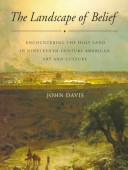Princeton Series in 19th Century Art, Culture, and Society
1 total work
This book tells of the 19th-century American painters who, along with photographers, archaeologists, writers, evangelists, and tourists, flocked to the biblical Holy Land, a world of striking landscape vistas that reflected, in their eyes, a powerful image of the United States. Here they saw a metaphor for their country: a New World promised land, a divinely favoured Protestant nation created by and for a modern "chosen people". Taking these biblical associations as a starting point, John Davis examines the ways in which 19th-century Americans looked to the actual landscape of the Holy Land as an extension of their national identity. Through close readings of panoramas, photographs, and conventional easel paintings, he shows how this "sacred topography" became a place to work out the competing ideological debates surrounding American exceptionalism, prophetic millennialism, anti-Muslim and anti-Jewish sentiment, and post-Darwinian science.
Drawing on sermons, diaries, travel volumes, and novels, Davis explores the growth of a specific cultural market for landscape imagery of Ottoman Palestine and the manner in which easel painters responded to the popular demand for vernacular repr
Drawing on sermons, diaries, travel volumes, and novels, Davis explores the growth of a specific cultural market for landscape imagery of Ottoman Palestine and the manner in which easel painters responded to the popular demand for vernacular repr
